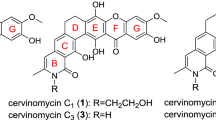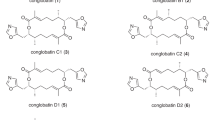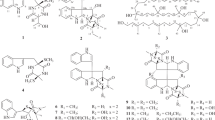Abstract
Potent and specific inhibitors of protein kinase C have been found in streptomyces and fungi: Staurosporine, an alkaloid from Streptomyces sp., is the most potent inhibitor of protein kinases with an IC50 in the nanomolar range. UCN-01 (7-hydroxy staurosporine), isolated from Streptomyces sp., is a selective inhibitor of protein kinase C with antitumor activity. Calphostin, isolated from the fungus Cladosporium cladosporioides, specifically inhibits protein kinase C (IC50 = 0.05 μM) without inhibiting other protein kinases. Microbial metabolites appear to be a promising source of inhibitors that target signal transduction pathways of eukaryotes.
This is a preview of subscription content, access via your institution
Access options
Subscribe to this journal
Receive 12 print issues and online access
$209.00 per year
only $17.42 per issue
Buy this article
- Purchase on Springer Link
- Instant access to full article PDF
Prices may be subject to local taxes which are calculated during checkout
Similar content being viewed by others
References
Hunter, T. 1987. A thousand and one protein kinases. Cell 50: 823–829.
Hanks, S.K., Quinn, A.M. and Hunter, T. 1988. The protein kinase family: conserved features and deduced phylogeny of catalytic domains. Science 241: 42–52.
Nishizuka, Y. 1986. Studies and perspectives of protein kinase C. Science 233: 305–312.
Castagna, M., Takai, Y., Kaibuchi, K., Sano, K., Kikkawa, U. and Nishizuka, Y. 1982. Direct activation of calcium-activated, phospholipid-dependent protein kinase by tumor-promoting phorbol esters. J. Biol. Chem. 257: 7847–7851.
Nishizuka, Y. 1988. The molecular heterogeneity of protein kinase C and its implication for cellular regulation. Nature 334: 661–665.
Tamaoki, T., Nomoto, H., Takahashi, I., Kato, Y., Morimoto, M. and Tomita, F. 1986. Staurosporine, a potent inhibitor of phospholipid/Ca2+ dependent protein kinase. Biochem. Biophys. Res. Commun. 135: 397–402.
Takahashi, I., Kobayashi, E., Asano, K., Yoshida, M. and Nakano, H. 1987. UCN-01, a selective inhibitor of protein kinase C from streptomyces. J. Antibiot. 40: 1782–1784.
Takahashi, I., Kobayashi, E., Asano, K., Kawamoto, I., Tamaoki, T. and Nakano, H. 1989. UCN-01 and UCN-02, new selective inhibitors of protein kinase C I. Screening, producing organism and fermentation. J. Antibiot. 42: 564–570.
Kase, H., Iwahashi, K., Nakanishi, S., Matsuda, Y., Yamada, K., Takahashi, M., Murakata, C., Sato, A. and Kaneko, M. 1987. K-252 compounds, novel and potent inhibitors of protein kinase C and cyclic nucleotide-dependent protein kinases. Biochem. Biophys. Res. Commun. 142: 436–440.
Hidaka, H., Inagaki, M., Kawamoto, S. and Sasaki, Y. 1984. Isoquino-linesulfonamide, novel and potent inhibitors of cyclic nucleotide dependent protein kinase and protein kinase C. Biochemistry 23: 5036–5041.
Hannum, Y.A. and Bell, R.M. 1988. Aminoacridines, potent inhibitors of protein kinase C. J. Biol. Chem. 263: 5124–5131.
Lomis, C.R. and Bell, R.M. 1988. Sangivamycin, a nucleotide analogue, is a potent inhibitor of protein kinase C. J. Biol. Chem. 263: 1682–1692.
Kobayashi, E., Nakano, H., Morimoto, M. and Tamaoki, T. 1989. Calphostin C (UCN1028C), a novel microbial compound, is a highly potent and specific inhibitor of protein kinase C. Biochem. Biophys. Res. Commun. 159: 548–553.
Kuyama, S. and Tamura, T. 1957. Cercosporin, a pigment of Cercosporina kikuchii. J. Am. Chem. Soc. 79: 5725–5729.
Mori, T., Takai, Y., Minakuchi, R., Yu, B. and Nishizuka, Y. 1983. Inhibitory action of chlorpromazine, dibucaine and other phospholipid-interacting drugs on protein kinase C. J. Biol. Chem. 255: 8378–8380.
Wise, B.C. and Kuo, J.F. 1983. Modes of inhibition by acylcarnitines, adriamycin and trifluoperazine of cardiac phospholipid-sensitive calcium-dependent protein kinase. Biochem. Pharmacol. 32: 1259–1265.
O'Brian, C.A., Liskamp, R.M., Solomon, D.H. and Weinstein, I.B. 1985. Inhibition of protein kinase C by tamoxifen. Cancer Res. 45: 2462–2465.
Marx, M.H., Piantadosi, C., Noseda, A., Daniel, L.W. and Modest, E.J. 1988. Synthesis and evaluation of neoplastic cell growth inhibition of 1-N-alkylamide analogues of glycero-3-phosphocholine. J. Med. Chem. 31: 858–863.
Hannun, Y.A. and Bell, R.M. 1987. Lysosphingolipids inhibit protein kinase C: Implications for sphingolipidoses. Science 235: 670–674.
Mazzei, G.J., Katoh, N. and Kuo, J.F. 1982. Polymixin B is a more selective inhibition for phospholipid-sensitive Ca++-dependent protein kinase. Biochem. Biophys. Res. Commun. 109: 1129–1133.
Hannun, Y.A., Foglesong, R.J. and Bell, R.M. 1989. The adriamycin-iron (III) complex is a potent inhibitor of protein kinase C. J. Biol. Chem. 264: 9960–9966.
Omura, S., Iwai, Y., Hirano, A., Nakagawa, A., Awaya, J., Tsuchiya, H., Takahashi, Y. and Masuma, R. 1977. A new alkaloid AM-2282 of Streptomyces origin: taxonomy, fermentation, isolation and preliminary characterization. J. Antibiot. 30: 275–281.
Nakano, H., Kobayashi, E., Takahashi, I., Tamaoki, T., Kuzuu, Y. and Iba, H. 1987. Staurosporine inhibits tyrosine-specific protein kinase activity of Rous sarcoma virus transforming protein p60. J. Antibiot. 40: 706–708.
Fujita-Yamaguchi, Y. and Kathuria, S. 1988. Characterization of receptor tyrosine-specific protein kinases by the use of inhibitors. Staurosporine is a 100 times more potent inhibitor of insulin receptor than IGF-1 receptor. Biochem. Biophys. Res. Commun. 157: 955–962.
Nakadate, T., Jeng, A.Y. and Blumberg, P.M. 1988. Comparison of protein kinase C functional assays to clarify mechanisms of inhibitor action. Biochem. Pharmacol. 37: 1541–1545.
Kobayashi, E., Takahashi, I., Nakano, H. and Tamaoki, T. Staurosporine inhibits the catalytic domain of protein kinases. In preparation.
Ruegg, U.T. and Burgess, G.M. 1989. Staurosporine, K-252 and UCN-01: potent but nonspecific inhibitors of protein kinases. Trends Pharmacol. Sci. 10: 218–220.
Takahashi, I., Saitoh, Y., Yoshida, M., Sano, H., Nakano, H., Morimoto, M. and Tamaoki, T. 1989. II. Purification, physico-chemical properties, structural determination and biological activities. J. Antibiot. 42: 571–576.
Okabe, H., Akinaga, S., Morimoto, M., Tamaoki, T. and Hirata, T. Antitumor effect of UCN-01, a novel PKC inhibitor, on tumor cell lines in vitro and in vivo, p. 413. 1990. Abstracts of the 81st Annual Meeting of the A.A.C.R.
Tanida, S., Takizawa, M., Takahashi, T., Tsubotani, S. and Harada, S. 1989. TAN-999 and TAN-1030A, new indolocarbazole alkaloids with macrophage-activating properties. J. Antibiot. 42: 1619–1630.
Morioka, H., Ishihara, M., Shibai, H. and Suzuki, T. 1985. Staurosporine-induced differentiation in a human neuroblastoma cell line, NB-1. Agric. Biol. Chem. 49: 1959–1963.
Oka, S., Suzuki, H. and Sata, A. 1985. Jpn. Kokai Tokkyo Koho Jp 60-188325.
Sezaki, M., Sakai, T., Nakazawa, T., Takeda, U., Iwata, M., Watanabe, T., Koyama, M., Kai, F., Shomura, T. and Kojima, M. 1985. A new antibiotic SF-2370 produced by Actinomadura, J. Antibiot. 38: 1437–1439.
Bush, J.A., Long, B.H., Catino, J.J. and Bradner, W.T. 1987. Production and biological activity of rebeccamycin, a novel antitumor agent, J. Antibiot. 40: 668–678.
Matson, J.A., Claridge, C., Bush, J.A., Titus, J., Bradner, W.T. and Doyle, T.W. 1989. AT2433-A1, A2, B1, B2, novel antitumor antibiotic compounds produced by Actinomadura melliaura, J. Antibiot. 42: 1547–1555.
Kobayashi, E., Ando, K., Nakano, H., Iida, T., Ohno, H., Morimoto, M. and Tamaoki, T. 1990. Calphostins (UCN1028), novel and specific inhibitors of protein kinase C. I. Fermentation, isolation, physicochemical properties and biological activities. J. Antibiot. 42: 1470–1474.
Iida, T., Kobayashi, Yoshida, M. and Sano, H. 1990. II. Chemical structures. J. Antibiot. 42: 1476–1481.
Yoshihara, T., Shimanuki, T., Araki, T. and Sakamura, S. 1975. Phleichrome; a new phytotoxic compound by Cladosporium phlei. Agr. Biol. Chem. 39: 1683–1684.
Arnone, A., Camarda, L., Nasini, G. and Merlini, L. 1985. Secondary mould metabolites. Part 13. Fungal perylenequinones: phleichrome, isophleichrome and their endoperoxides. J. Chem. Soc. Soc. Perkin Trans. I. 1387–1392.
Author information
Authors and Affiliations
Rights and permissions
About this article
Cite this article
Tamaoki, T., Nakano, H. Potent and Specific Inhibitors of Protein Kinase C of Microbial Origin. Nat Biotechnol 8, 732–735 (1990). https://doi.org/10.1038/nbt0890-732
Issue Date:
DOI: https://doi.org/10.1038/nbt0890-732
This article is cited by
-
Chemical profiling of Streptomyces sp. for detection of potential pharmaceutical molecules
Biologia (2023)
-
An open source extrusion bioprinter based on the E3D motion system and tool changer to enable FRESH and multimaterial bioprinting
Scientific Reports (2021)
-
A Phase 1 study of UCN-01 in combination with irinotecan in patients with resistant solid tumor malignancies
Cancer Chemotherapy and Pharmacology (2011)
-
Treatment of non-small-cell lung cancer: state of the art and development of new biologic agents
Oncogene (2003)
-
Ras pathway signals are required for notch-mediated oncogenesis
Oncogene (2000)



